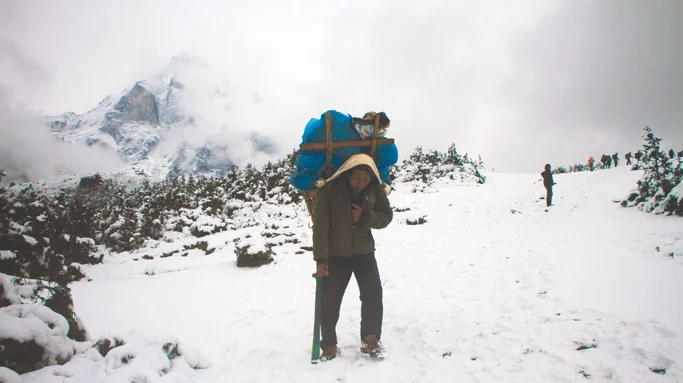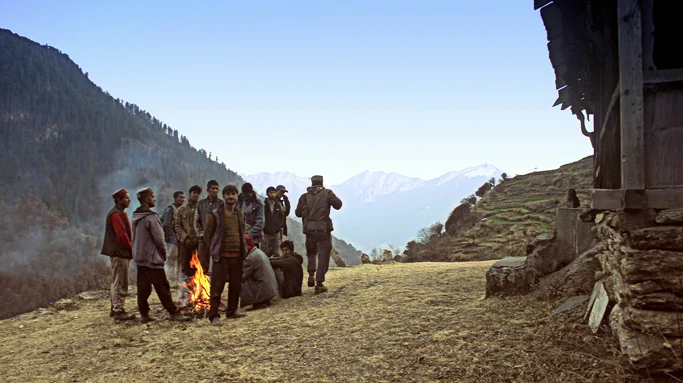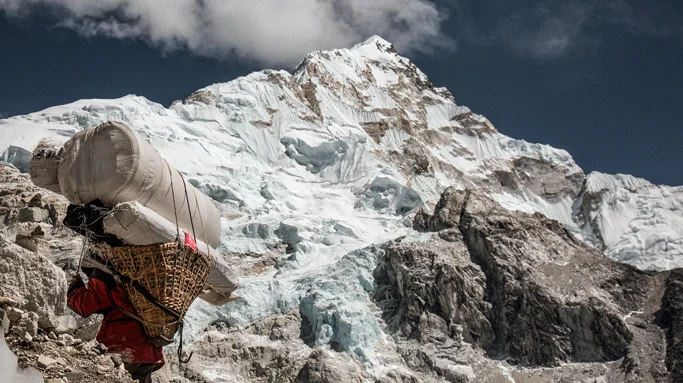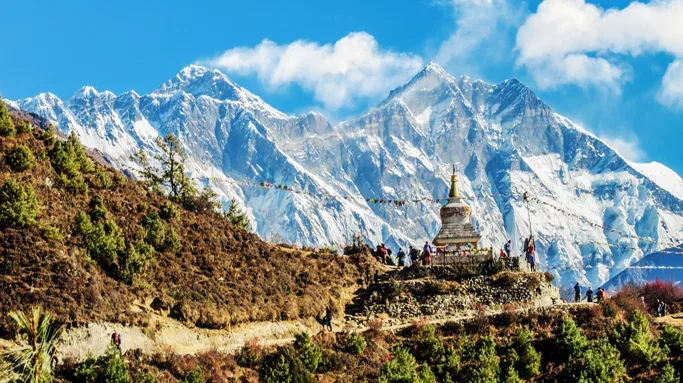Newsletters Trips@Asia
Sherpas: Heroes of the Himalayas
On May 29th, 1953, Sir Edmund Hillary became known as the first person to stand atop Mount Everest. However, he was not alone at the top of the world! Since then, over 4,000 climbers have successfully summited the mountain. We learn about the challenges they overcame in their quest to reach the world's highest peak through interviews, books, and movies. However, many of us never heard about the men who made these dangerous journeys possible- the Sherpas of the Himalayas!

Climbing Everest requires a considerable amount of equipment and supplies and might end in catastrophe if not meticulously prepared. No climber would have been able to conquer Everest if they carried all this essential equipment by themselves. Fortunately, the Sherpas, a Tibetan ethnic group residing in the mountainous regions of Nepal, have been there to help climbers and adventurers for the better part of a century. Sherpas do everything on the mountain, including setting up camp, fixing ropes in place, helping change oxygen bottles, and carry the necessary climbing kit up the mountain. They take the heaviest loads and often pay the highest prices while attempting to fulfill their tasks. Over the years, many Sherpas have disappeared on the mountain, never to be seen again. While scuffle between Sherpas and some Western mountaineers received global attention just a few years ago, no media outlets report when Sherpas fall to their death. There are also many grim stories about Sherpas who were left to die on the mountain while serving clients. Most notoriously, the Nazi climbing team in 1939 put on their skis and abandoned their Sherpas when a storm hit.

The greatest challenge for mountaineers climbing Mount Everest is the extremely high altitude. The oxygen level at the summit is one-third of that at sea level. Thus, it is nearly impossible for people to climb without supplementary oxygen. Altitude sickness can strike at as low as 2,500 meters, and the human body struggles to adapt as a person ascend to greater heights. One may feel dizziness, experience low blood pressure, or have trouble breathing. Eventually, if not promptly treated, it would lead to certain death. The same can't be said about Sherpas. According to oral history, Sherpas migrated to northeastern Nepal from bordering Tibet in the 15th century to escape ongoing civil wars. To avoid conflict with locals, they settled in the uninhabited uplands reaching 4,500 meters above sea level. After centuries of living at high altitudes, their bodies have evolved to survive in an oxygen-limited environment. Their hearts can utilize glucose, and their lungs have increased efficiency in low oxygen altitude. Thus, people of the Sherpa ethnicity deal at relative ease with the physical challenges posed by climbing some of the world's highest peaks.

However, despite their mountain climbing gift, Sherpas had not attempted to scale the region's mountains, which they worship, until the last century. As adventurers began arriving to challenge the country's famous peaks since the 1920s, the Sherpas found themselves working as guides and porters due to their familiarity with the terrain. The first Sherpa to reach the top of Mount Everest was Tenzing Norgay. His parents were yak-herders in a village near Everest, who struggled to feed their 13 children. Tenzing ran away from home twice as a teenager, first to Kathmandu and then to Darjeeling, India, which marked the starting point for mountain climbing expeditions to the eastern Himalayas at the time. There he first saw foreign climbers and was intrigued by their passion. While most Sherpas feared to scale the great peaks, other than a way to making a living, Tenzing aspired to become a professional mountaineer, not just a porter. He received his first opportunity to attempt Everest at 19 as part of Eric Shipton's 1935 expedition. He took part in several other failed attempts over the years, including the 1952 Swiss expedition, where he made it within 250 meters of the summit, the highest that anyone had ever been. His group only turned back due to a shortage of equipment β no sleeping bags, no stove, and no enough drinking water to keep at such a high altitude for the night, and were thus forced to revert to basecamp.

Inspired by the near-success of the Swiss, the British organized a large expedition the following year. Tenzing led the team of Sherpas and attempted to reach the summit for the seventh time. He later told journalists that "Six times I climbed the mountain. The seventh time, I told myself I cannot fail." The expedition chose two climbing pairs to climb to the top. The first pair was Tom Bourdillon and Charles Evans, while the second included Edmund Hillary and Tenzing Norgay. The first group nearly made it, coming within 100m of the summit, but they turned back, running out of oxygen. Tenzing and Hillary set out the next day. They survived a freezing night on the mountain and reached the South Summit, now known as the Hillary Step, by 9 am. At about 11:30 am on May 29th, 1953, the climbers became the first humans to arrive at the peak of Mount Everest. The news of their success spread across the world. Queen Elizabeth II knighted Hillary but awarded Tenzin with the lesser British Empire Medal due to him not being a Commonwealth citizen.

Since Hillary and Norgay's historic climb, Mount Everest has become the ultimate goal for adventurers to push their boundaries and their claim to fame. Sherpa climbing guides have helped thousands of mountaineers to fulfill their dream. While Tenzin Norgay made history, Apa Sherpa broke the world record in 2011 after claiming his 23rd summit of Mount Everest. The nearest non-Sherpa record belongs to David Hahn, who achieved his 14th summit. Apa survived an avalanche at the age of three months with his mother. Although he wanted to become a doctor, he was forced to give up on his dream after his father died. He took up the responsibility to take care of his five siblings and left school to work as a porter for mountaineering expeditions at only 12. Working primarily as a kitchen boy, he only reached the summit at age 30. He repeated the feat almost every year after, becoming Everest's top guide and earning the nickname "Super Sherpa." Now retired and living in Utah, Apa returns every year to his hometown in the Himalayas to provide financial aid to schools and show children from the Sherpa minority that they have other options in life. He once said in an interview, "Sherpas take great risks in the mountains to earn a living for their families because they can't take up any other jobs. My main goal is to ensure children don't have to climb, as we did, in the future."

Indeed, working as a Sherpa on Everest is one of the riskiest jobs in the world. On top of avalanches and snowstorms, they must endure collapsing crevasses, frostbites, and winds that can blow you off the mountain. They then have to survive the infamous death zone above an altitude of 8,000 meters, where oxygen levels drop too low to sustain human life for a lengthy period. The summit of Everest is at 8,848 meters, making the death zone inevitable. The bravest Sherpas of Everest take the job known as Icefall doctors. They attach ropes and ladders in the Khumbu Icefall, where house-sized slabs of ice hang and sometimes fall. These Sherpas spend up to 16 hours a day in the Icefall, while the climbers only pass through it for a very short time. Despite all the risks, most Sherpas go on an expedition twice a year as it is the only way to take their families out of poverty. It is hard for Sherpa youth to continue their studies beyond the primary level because their remote villages are connected to the rest of the country by only gravel footpaths. As most of them don't have any education, they take the only available high-paying jobs- porters and mountain guides. Experienced guides who take climbers to the top of Everest make $8,000, while porters or cooks at the camps average at $3,000 during their three months of work. That's a considerable amount compared with Nepal's $1,035 annual per capita income.

However, this life-changing pay may no longer encourage the younger generation of Sherpas to work in the mountains. A Sherpa working in Everest is nearly ten times more likely to die than a commercial fisherman, the most dangerous nonmilitary job in the United States. No service industry in the world so frequently kills or mutilates its workers for the amusement of paying clients. Kaji Sherpa, a 39-year-old senior climber, lost 16 of his colleagues in the 2014 avalanche. The team was there to prepare a path for their clients, fixing ropes on the ice field. He told the press that he would never set foot on Everest again and work as a farmer instead. After the loss of so many lives at once, the Sherpa community in the Himalayas refused to work anymore. The revolt has stoked disarray in the government, with the tourism minister flying to the base camp to defuse anger. The government promised to force guiding agencies to increase their life insurance policies for Sherpas from $10,000 to $15,000. However, this sum is still not a hefty amount for a family that lost its breadwinner, so climbers sometimes fundraise to help as well. Helicopters are also being used more often to perform high-altitude rescues of Sherpas. Rescues are paid through government-mandated insurance policies, but sometimes local outfitters pay the difference in costs. In 2015, a magnitude 7.8 earthquake struck Nepal and triggered another massive avalanche, killing ten Sherpas at Everest Base Camp. Due to consecutive incidents, many Sherpas are now investing much of their income for their children's education so that they wouldn't have to follow their fathers' footsteps up the mountains.

Most veteran Sherpas admit that they wouldn't have become mountain guides if they had the opportunity to find other well-paying jobs. But it is hard for the Sherpas to walk away from the climbing industry, which has turned many poor men into rather rich people. With many foreign climbers giving the impression that climbing Everest is not as hard as one would expect, increasing numbers of inexperienced climbers do take on the challenge of tackling Everest every year. Climbers with no experience and proper fitness level make the job of Sherpas harder than it already is. Some famous Sherpa mountain guides stated that overcrowding of tourists should be stopped. However, the coronavirus pandemic proved that their livelihoods would be at severe risk without these tourists. Obviously, most Sherpas have little to no education or skills in other fields, so they depend solely on their climbing and mountain survival skills. When tourists' arrivals halted last year, the Sherpas' financial and food security went downhill. Nepal is responding to the growing humanitarian crisis by officially opening its borders to vaccinated travelers in an attempt to generate incomes nationwide, but no less so, to support Sherpa communities high in the Himalayas. Most Sherpas are now hoping to see the tourists again, and despite the hurdles and challenges, to once again take their icepicks and crampons and ascend the peaks that put food on their plates, but that could, at a careless second, take their lives.
NEPAL LUXURIOUS TREKKING TRIP
This trip is a fantastic opportunity for those looking to experience mild trekking in Nepal, or for families wanting to spend time trekking together while enjoying some of the coziest lodging facilities Nepal has to offer.
View Tour